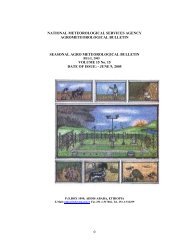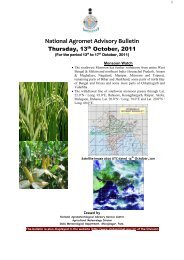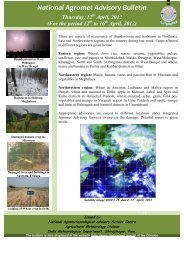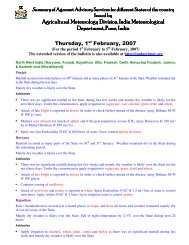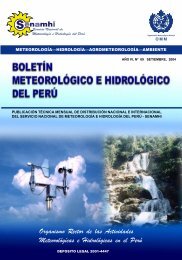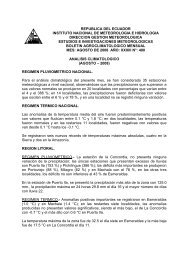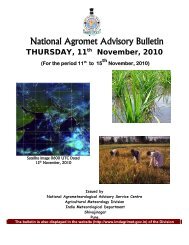Hydrological Threats to Ecosystem Services Provided by USDA ...
Hydrological Threats to Ecosystem Services Provided by USDA ...
Hydrological Threats to Ecosystem Services Provided by USDA ...
You also want an ePaper? Increase the reach of your titles
YUMPU automatically turns print PDFs into web optimized ePapers that Google loves.
<strong>Hydrological</strong> <strong>Threats</strong> <strong>to</strong> <strong>Ecosystem</strong> <strong>Services</strong><strong>Provided</strong> <strong>by</strong> <strong>USDA</strong> Forest ServiceYongqiang LiuCenter for Forest Disturbance Science<strong>USDA</strong> Forest Service, Athens, GA, USAInternational Symposium on Synergistic Approaches <strong>to</strong>Food and Water SecurityGeorge Mason University. Oc<strong>to</strong>ber 17-19, 2012
Water related forest ecosystem services(Millennium <strong>Ecosystem</strong> Assessment, 2005)RegulatingProvisioningRegulating services are benefitsobtained from the regulation of ecosystemprocesses – flow and ground water, soilerosion, water purification and watertemperature.SupportingCulturalProvisioning services include productsobtained from ecosystems – conserve waterresources.Supporting services include theecological elements and processes <strong>to</strong>sustain ecosystems – soil-vegetationatmospherewater cycling.Cultural services benefit people throughwater related recreationAbout 80 percent of the Nation’s scarcefreshwater resources originate on forests,25~1000 mm per unit area of land per year(Brown et al. 2008).
<strong>Hydrological</strong> threats<strong>Hydrological</strong> threats <strong>to</strong>forest ecosystem services- stressed or degraded forest water conditions due <strong>to</strong> natural or human fac<strong>to</strong>rs.Natural contribu<strong>to</strong>rs-climate variability (droughts) and climate change (global warming)-climate can affect the hydrologic cycle and thus water quality and quantity fromforests. Critical forest ecosystem services can be threatened or compromised.Issues-Current hydrological threats <strong>to</strong> U.S. forest ecosystem-Future trends in the hydrological threatsObjectives-<strong>Hydrological</strong> conditions in the U.S. through analyzing water indices (Liu 2011, Liuet al. 2012)-<strong>Hydrological</strong> conditions in the South from water research, part of Southern ClimateChange Adaptation and Mitigation Management Option project (Marion et al. 2012)
Threat Indica<strong>to</strong>r (soil)Keetch-Byram Drought Index (KBDI)- Soil moisture deficit, measuring the amount ofprecipitation necessary <strong>to</strong> return the soil <strong>to</strong> full saturation- Determined <strong>by</strong> maximum temperature, daily rainfall,average annual rainfall.Forest drought classificationLow(0-200)Soil moisture and large class fuel moistures are high. Typical ofspring dormant season following winter precipitation.Moderate(200-400)Lower litter and duff layers are drying. Typical of late spring, earlygrowing season.High(400-600)Extreme(600-800)Lower litter and duff layers are dry. Typical of late summer, earlyfall.Lower litter and duff layers are very dry. Live fuels can also be dryat these levels. Often associated with more severe drought.
Threat Indica<strong>to</strong>r (vegetation)- Ratio of water and dry weights of dead or live fuels.- Dead fuel moisture responds solely <strong>to</strong> ambientenvironmental conditionsDead fuel moisture classification1-h,
Current and future climate- From the North America Regional climate change assessmentprogram (NARCCAP), an international program <strong>to</strong> produce highresolution climate change simulations <strong>to</strong> investigate uncertainties inregional scale projections of future climate and generate climatechange scenarios for use in impacts research.- Run a set of regional climate models (RCMs) driven <strong>by</strong> a set ofGCMs over North America.- Simulations for the current period 1971-2000 and for the futureperiod 2041-2070 at a spatial resolution of 50 km with the IPCC SRESA2 emissions scenario for the 21st century .- Simulations with HRM3 driven <strong>by</strong> HadCM3 were used for the resultspresented and compared with other simulations for specific regions.
Present (<strong>to</strong>p)and futurechange(bot<strong>to</strong>m)seasonalprecipitation(mm)
Present (<strong>to</strong>p)and futurechange(bot<strong>to</strong>m)temperature(max. o C)
Present(<strong>to</strong>p) andfuturechange(bot<strong>to</strong>m)KBDI
Degraded hydrological conditions
Present(<strong>to</strong>p) andfuturechange(bot<strong>to</strong>m)fuelmoisture(%)
Trends of U.S. summer KBDI (<strong>to</strong>p) and seasonalfuel moisture (bot<strong>to</strong>m) over 30-year periodThe red and green curves represent the present period of 1971-2000 andfuture period of 2041-2070. The red line is slope of present variations.
Increasing wildfire trendsresulted partially from drying foresthydrological conditions
Inner (left) and inter (right) year variability
Comparison with other models
Water Yield (mm)Future trends in southern water yieldMean trends predicted for2010-2060 in mean annualwater yield, normalized <strong>by</strong>2001-2010 mean annualwater yield. Hatched arearepresents locations wherethe predicted trend in wateryield is statistically significant(p < 0.05).450400350300250200150100(b)2010 2020 2030 2040 2050 2060Predicted South-wide 10-yrmoving-mean annual wateryield. The green arearepresents the range inpredicted water yield overthe four climate projections.
Mean annual Water Supply Stress Index(a ratio of water demand/water supply) based on four climate projectionsfor (a) Baseline (2001-2010), and (b) Future (2051-2060)(a) Baseline(b) Future
Conclusions• Current threats of hydrological conditions are high in theinter-mountains all seasons and the South in summer.• The drying trend is happening and is expected <strong>to</strong>continue in this century.• Larger variability is expected for the costal regions.• Increasing water shortage is expected for many southernareas.
Thanks!



